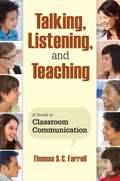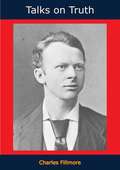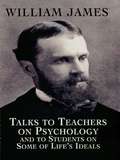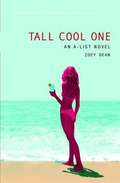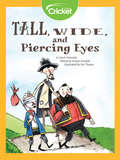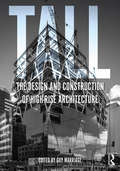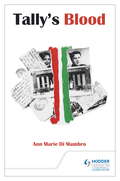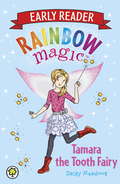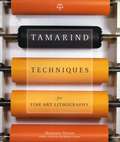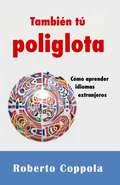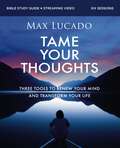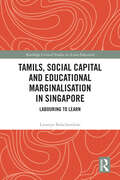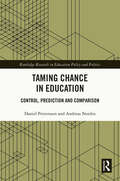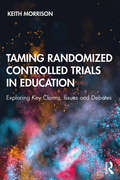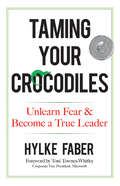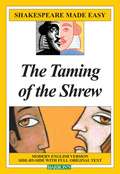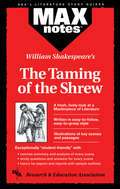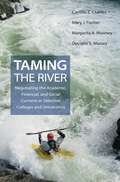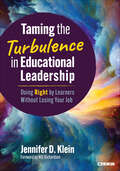- Table View
- List View
Talking, Listening, and Teaching: A Guide to Classroom Communication
by Thomas S. FarrellTalking, Listening, and Teaching demonstrates how important it is for teachers to understand and monitor classroom communication patterns and resolve problems that may hamper students' learning. Using examples from real classrooms, the author explainsHow classroom talk is different from communication outside the classroomHow to gather and analyze data about classroom talkWhat type of questioning generates good discussionsWhy and how to give feedback to studentsHow nonverbal communication impacts the classroomThis insightful guide to classroom communication, featuring provocative "Thinking About Your Own Classroom" questions, is ideal for teacher study groups and benefits educators who wish to effectively manage this important aspect of teaching and learning.
Talks on Truth (Unity Classic Library #2)
by Charles FillmoreOriginally published in 1926, this book presents fourteen enlightening talks by Unity’s co-founder Charles Fillmore. It explores the metaphysical aspects of Christianity and the basic principles on which the Unity movement were founded. There is also a question chapter on all fourteen lessons at the end of the book.Lesson subjects are: Reform Your God Thought; Microorganisms; The I Am In Its Kingdom; How Shall The Dead Be Raised?; The Development Of Divine Love; The Ministry Of The Word; Ye Must Be Born Again; Obedience; The Church Of Christ; The Lord’s Body; The Restoration Of God’s Kingdom; The Holy Spirit; Attaining Eternal Life; and, Jesus Christ’s Atonement.
Talks to Teachers on Psychology: and to Students on Some of Life's Ideals
by William JamesStill-vital lectures on teaching deal with psychology and the teaching art, the stream of consciousness, the child as a behaving organism, education and behavior, and more. The three addresses to students are "The Gospel of Relaxation," "On a Certain Blindness in Human Beings," and "What Makes a Life Significant?" Preface. 2 black-and-white illustrations.
Tall Cool One (A-List Novel #4)
by Zoey DeanTall Cool One is the fourth novel in this witty series that takes readers behind the scenes of the intoxicating world of Hollywood glitterati. New York blueblood Anna Percy came to L.A. to learn how to have a good time. Now she's surfing Zuma Beach with the industry's hottest young television producer. But duty calls and Anna must jet down to Las Casitas, Mexico, on a secret mission for her uber-powerful businessman father. But it turns out Anna isn't the only one staying at the super-luxury resort with a secret.
Tall, Wide, and Piercing Eyes
by Siena LeslieThe prince must rescue the princess! An evil wizard has trapped her in a castle and turns all of her potential rescuers into stone. In order to marry her, the prince will need to save her! During his journey, he meets three new friends with magical abilities. Together, they work to find a way to rescue the princess. Will the prince get his happily ever after?
Tall: the design and construction of high-rise architecture
by John Sutherland Guy Marriage Nabil Jose Allaf Gerard Finch Lauren HayesThis is a guide to both the basics and the details of tall building design, delving into the rudimentary aspects of design that an architect of a tall office building must consider, as well as looking at the rationale for why and how a building must be built the way it is. Liberally illustrated with clear, simple black and white illustrations showing how the building structure and details can be built, this book greatly assists the reader in their understanding of the building process for a modern office tower. It breaks down the building into three main components: the structure, the core and the facade, writing about them and illustrating them in a simple-to-understand manner. By focusing on the nuts and bolts of real-life design and construction, it provides a practical guide and desk-reference to any architect or architecture student embarking on a tall building project.
Tally Tuttle Turns into a Turtle (Class Critters)
by Kathryn HolmesTally Tuttle Turns Into a Turtle is the first in Kathryn Holmes’s humorous and heartfelt Class Critters chapter book series about a second grade class where each kid turns into an animal for a day—featuring illustrations by Ariel Landy. It’s Tally Tuttle’s first day of second grade, and she’s so nervous that she feels like she ate butterflies for breakfast! On top of moving to a new town and new school where she doesn’t know anyone, everyone starts teasing her when her full name, Tallulah, is revealed during roll call. She just wishes she could retreat into a shell . . . Then, all of a sudden, the desks and her classmates around her seem enormous, and Tally is shell-shocked to discover that she’s actually turned into a turtle! She’d heard that Mrs. Norrell’s class was special, but she hadn’t expected this. Tally likes having a shell to hide in, but there are other parts of turtle life—like the fear of being stepped on—that aren’t exactly ideal. And once she’s tired of hiding, how can she change back into a girl? Tally will have to forge her own transformation back to herself and come out of her shell—both literally and figuratively! In this chapter book series, Mrs. Norrell’s second grade classroom has magic that allows kids to transform into animals to learn important life lessons. Each book will follow a different kid and their animal transformation and will include fun natural science facts about the featured animal in the back matter.Class Critters series:Tally Tuttle Turns into a Turtle (#1)David Dixon’s Day as a Dachshund (#2)Madison Morris is NOT a Mouse! (#3)
Tally's Blood
by Ann MambroAs well as being a highly popular play for National 5 English study, Tally's Blood paints a wonderful picture of life in wartime Scotland, as experienced by the Italian immigrant community. Exploring the themes of racism, love and family loyalties, it does so with humour and warmth through the eyes of an Italian family with close blood ties. When World War Two breaks out, friendships outwith the family are sorely tested by the difficulties of wartime prejudice. - One of the set drama texts for National 5 English - Written by a very successful playwright and television screenplay writer
Tally's Blood
by Ann Marie MambroExam Board: SQALevel: National 4 & 5Subject: EnglishFirst Teaching: September 2013First Exam: June 2014As well as being a highly popular play for National 5 English study, Tally's Blood paints a wonderful picture of life in wartime Scotland, as experienced by the Italian immigrant community. Exploring the themes of racism, love and family loyalties, it does so with humour and warmth through the eyes of an Italian family with close blood ties. When World War Two breaks out, friendships outwith the family are sorely tested by the difficulties of wartime prejudice.- One of the set drama texts for National 5 English- Written by a very successful playwright and television screenplay writer
Tamara the Tooth Fairy (Rainbow Magic Early Reader #11)
by Daisy MeadowsCan Kirsty and Rachel help Tamara the Tooth Fairy do her job by getting her magical objects back from Jack Frost?
Tamarind Techniques for Fine Art Lithography
by Marjorie DevonThis comprehensive text covers all facets of fine art lithography, from setting up a workshop of any size to pulling a successful edition. It offers complete, illustrated step-by-step instructions for all techniques in use.
También tú Poliglota. Cómo aprender idiomas extranjeros
by Roberto Coppola LmapEste libro recoge las indicaciones de los grandes poliglotas y examina aquellos que, según mi experiencia como formador y traductor, son los métodos más eficaces de auto-enseñanza de las lenguas extranjeras. Un entero capítulo está dedicado a la preparación de un método personal “perfecto” para alcanzar el objetivo de aprender a conversar, leer y escribir en cuatro lenguas extranjeros en el plazo de dos años.
Tame Your Thoughts Bible Study Guide plus Streaming Video: Three Tools to Renew Your Mind and Transform Your Life
by Max LucadoRenewing your mind will lead to a transformed life.Have you been feeling weighed down by worry? Or caught up in a web of self-critical thoughts? The good news is that with God's help, you can learn to renew your mind, break free from negative patterns, and become a little more like Jesus every day. This six-session Bible study explores three scripture-based tools for managing your thoughts:Practice Picky Thinking: Monitor the airspace of your thoughts and don't allow the destructive ones to land.Identify UFOs: Scan for any untruths that are creating false narratives that are leading to overreactions.Uproot and Replant: Don't let the ugly weeds of Satan's lies grow. Pull them up by the roots and replace them with God's truth.These three tools will help you take every thought captive and test the messages that replay in your mind against the truth of God's Word. You will also learn to overcome common thought traps like anxiety, guilt, rejection, dissatisfaction, and more. No matter who you are or where you come from, progress is possible.This study guide includes:Individual access to six streaming video sessionsVideo notes and a comprehensive structure for group discussion timePersonal study for deeper reflection between sessionsA guide to best practices for leading a groupStreaming video access included. Access code subject to expiration after 12/31/2030. Code may be redeemed only by the recipient of this package. Code may not be transferred or sold separately from this package. Internet connection required. Eligible only on retail purchases inside the United States. Void where prohibited, taxed, or restricted by law. Additional offer details inside.
Tame Your Thoughts: Three Tools to Renew Your Mind and Transform Your Life
by Max LucadoNOW A NEW YORK TIMES BESTSELLER!When was the last time you awakened to a swirl of anxious, out-of-control thoughts?Perhaps you were overwhelmed with the weight of worry, the fear of failing, or the grip of guilt. The way we think directly impacts our joy and peace. In Tame Your Thoughts, Max Lucado provides three biblical and practical tools to renew your mind and transform your life.Our thoughts have consequences. Most people would agree that positive thoughts generate positive actions. Negative thoughts activate negative behavior. But do we understand that we can manage our lives by managing our thoughts? Not only does neuroscience back this concept, but the idea is also embedded throughout Scripture. "Do not be conformed to this world but be transformed by the renewal of your mind" (Rom.12:2 esv). Tame your thoughts and transform your life!Stuck in your head? Hounded by regrets? Weighed down by worry? Change is possible! The thoughts that have characterized your past need not characterize the rest of your life. You will learn to:Take thoughts captiveTest each message against the truth of ScriptureInterrupt poisonous thought threadsThink and act like Jesus If God can resurrect the dead, can he not resurrect hope? Defy depression? Clarify confusion? Silence shame? Destroy doubt? Banish bitterness?Take God at his word. "For God has not given us a spirit of fear, but of power and of love and of a sound mind" (2 Tim. 1:7 nkjv, emphasis added). With God as their helper, you will discover a new way of thinking and a better way of living. A new person will begin to emerge.We can tame each thought, friends.
Tamil Mozhi Varalaru
by SakthivelThis book talks about the history of the ancient language Tamil and the way it's literature flourished during different dynasities and goes on to talk about the present day Tamil.
Tamils, Social Capital and Educational Marginalization in Singapore: Labouring to Learn (Routledge Critical Studies in Asian Education)
by Lavanya BalachandranLabouring to Learn examines academic mobility pathways among ethnic minority Tamil youths in public secondary schools and vocational institutions in Singapore. The book qualitatively examines the interactive effects of race and class on the educational performance of Tamil youths through the lens of social capital. Despite their numerically majoritarian position within the Indian population in Singapore, the foreclosed access for Tamils to diverse class networks within the ethnic community as well as limited inter-ethnic interactions has historically truncated the means to resources and opportunities for social mobility. In schools, the narratives of Tamil boys and girls from the weaker academic streams and economically disadvantaged backgrounds reveal that they typically experience exclusion on account of racial, economic and academic marginalization in their everyday lives. Turning to bonding ties among peers and family members provide social support resources that offer some respite from marginalization. On the flipside, articulations of resistance ensue among Tamil youths that tangibly take time away from learning on one hand, but on the other, runs the danger of empowering the cultural deficit rhetoric for mainstream society to explain poor academic performance among ethnic minorities. The account of educational marginalization amongst Singaporean Tamil youths contributes towards understanding social inequality in a non-liberal multicultural context where marginalization is differentially experienced across ethnic minority groups and traced to broader socio-historical contexts of migration, assimilation and minority-majority relations. Furthermore, it also articulates the utility of a social capital framework in historically revealing how educational inequality emerged and continues to be sustained in a postcolonial context.
Taming Chance in Education: Control, Prediction and Comparison (Routledge Research in Education Policy and Politics)
by Daniel Pettersson Andreas NordinThis volume centres the notion of ‘chance’ in education as a key concept in contemporary education – relating to aspects like accountability, datafication, or international large-scale assessments – and discusses the impact that the historical desire to ‘tame’ this notion has had on present day educational policy and practise. Encouraging readers to widen their educational imagination, chapters combine secondary research from the fields of cybernetics, systems thinking and comparative education with issues of control, prediction, and comparison as ways to tame chance in education. Using the theoretical lenses of reasoning, notions, and addendums for legitimacy to foster a critical awareness of rarely discussed educational matters, the book explores how these notions are central to the taming of chance within education. Ultimately, the authors determine the styles of reasoning that are foundational and frame how we think about, and act on, education, and thereby address one of the top priorities in educational policy, politics, and practice today. This timely book, with its unique perspective on the debates around education, will be of interest to students, researchers and scholars in the fields of education policy and politics, international and comparative education, and theory of education. Those involved with the philosophy of education will also find the book valuable.
Taming Randomized Controlled Trials in Education: Exploring Key Claims, Issues and Debates
by Keith MorrisonThere is a recent surge in the use of randomized controlled trials (RCTs) within education globally, with disproportionate claims being made about what they show, ‘what works’, and what constitutes the best ‘evidence’. Drawing on up-to-date scholarship from across the world, Taming Randomized Controlled Trials in Education critically addresses the increased use of RCTs in education, exploring their benefits, limits and cautions, and ultimately questioning the prominence given to them. While acknowledging that randomized controlled trials do have some place in education, the book nevertheless argues that this place should be limited. Drawing together all arguments for and against RCTs in a comprehensive and easily accessible single volume, the book also adds new perspectives and insights to the conversation; crucially, the book considers the limits of their usefulness and applicability in education, raising a range of largely unexplored concerns about their use. Chapters include discussions on: The impact of complexity theory and chaos theory. Design issues and sampling in randomized controlled trials. Learning from clinical trials. Data analysis in randomized controlled trials. Reporting, evaluating and generalizing from randomized controlled trials. Considering key issues in understanding and interrogating research evidence, this book is ideal reading for all students on Research Methods modules, as well as those interested in undertaking and reviewing research in the field of education.
Taming Your Crocodiles: Unlearn Fear & Become a True Leader
by Hylke Faber"I do believe that the issue of fear is personal and that is why it is buried in the workplace. Taming Your Crocodiles is groundbreaking not only because of its structured methodology, but also for its courage in calling out the issue itself. I am deeply impacted by Taming Your Crocodiles. I can speak personally and freely on this topic because this work has liberated me to lead more fearlessly at Microsoft and beyond." — Toni Townes-Whitley, Corporate Vice President, Microsoft Worldwide Public Sector and Industry What does it take to become a great leader? True leadership means freeing yourself from false, mostly borrowed constraints, charting a purpose-filled path based on values that reflect who you really are, and inspiring others to do the same. Before becoming a coach to CEOs and other leaders worldwide, Hylke Faber had his own transformational journey, stepping back from a high-stress career as a strategy consultant in New York City and almost becoming a monk in order to discover a more holistic approach to life. This book distills his experience into a guide that will help you grow into the leader you really are by transforming your "crocodilian" fear-based conditioning into "owls" — mindsets and behaviors that reflect your true essence. In this bold, comprehensive book, Hylke offers practical advice for coaching yourself and others, both one-on-one and one-to-many, influencing the people around you to evolve their mindsets and behaviors to a more authentic place. Every chapter includes tools Hylke has successfully used in his work that you can apply to become a more truthful leader, both at work and at home. With Taming Your Crocodiles, you can learn how to let go of fear, unlock your potential for growth, and foster a supportive environment for your team, in which presence, learning, contribution, and excellence merge. Some of the tools include AWE (Always Willing to Evolve), LOVE (Letting Others Voluntarily Evolve), and SUCCESS (be a Samurai, Unite, Center in Purpose, be Curious, Extend Contribution, Sense Your Environment and be Simple). "Taming Your Crocodiles is a daring and important addition to the field of leadership development. It's personal, provocative, and practical. It challenges us to become radically honest with ourselves about who we really are and how our learned crocodilian fears are holding us back from who we can be. And it provides an inspiring, well-structured path to help us coach ourselves and others to let go of our crocodiles and lead from a place that realizes much more of our true potential." — Vijay Govindarajan, Coxe Distinguished Professor, Dartmouth College's Tuck School of Business; Marvin Bower Fellow 2015–16, Harvard Business School; New York Times, Wall Street Journal bestselling author "In this simple but transformative book, you have everything — absolutely everything — you need to go on life's greatest journey to grow as a leader, not by changing yourself but rather by discovering who you are becoming." — Chris Ernst, Director, Learning & Organization Effectiveness, Bill & Melinda Gates Foundation; author of Boundary Spanning Leadership "Inspiring, thought-provoking, and comprehensive. Taming Your Crocodiles offers a compelling combination of process, stories, and practice. It invites us to reflect on who we are and how to lead ourselves and others from an authentic place. Including lessons from the great leaders of our time, it helps readers to evolve by becoming more conscious of their inherent strengths and more free from self-limiting mind-sets and behaviors. A must-read for anyone who wishes to grow their leadership to the next level!" — Joel Brockner, Phillip Hettleman Professor of Business, Columbia Business School
Taming of the Shrew (Shakespeare Made Easy)
by William ShakespeareA Simon & Schuster eBook. Simon & Schuster has a great book for every reader.
Taming of the Shrew, The (MAXnotes Literature Guides)
by Christopher GarcezREA's MAXnotes for William Shakespeare's The Taming of the Shrew The MAXnotes offers a comprehensive summary and analysis of The Taming of the Shrew and a biography of William Shakespeare. Places the events of the play in historical context and discusses each act in detail. Includes study questions and answers along with topics for papers and sample outlines.
Taming the River: Negotiating the Academic, Financial, and Social Currents in Selective Colleges and Universities (The William G. Bowen Series #51)
by Douglas S. Massey Mary J. Fischer Camille Z. Charles Margarita A. MooneyBuilding on their important findings in The Source of the River, the authors now probe even more deeply into minority underachievement at the college level. Taming the River examines the academic and social dynamics of different ethnic groups during the first two years of college. Focusing on racial differences in academic performance, the book identifies the causes of students' divergent grades and levels of personal satisfaction with their institutions. Using survey data collected from twenty-eight selective colleges and universities, Taming the River considers all facets of student life, including who students date, what fields they major in, which sports they play, and how they perceive their own social and economic backgrounds. The book explores how black and Latino students experience pressures stemming from campus racial climate and "stereotype threat"--when students underperform because of anxieties tied to existing negative stereotypes. Describing the relationship between grade performance and stereotype threat, the book shows how this link is reinforced by institutional practices of affirmative action. The authors also indicate that when certain variables are controlled, minority students earn the same grades, express the same college satisfaction, and remain in school at the same rates as white students. A powerful look at how educational policies unfold in America's universities, Taming the River sheds light on the social and racial factors influencing student success.
Taming the Turbulence in Educational Leadership: Doing Right by Learners Without Losing Your Job
by Jennifer D KleinLearner-centered leadership grounded in courage, integrity, and love for every child The pressures of today’s political and cultural climate have created unprecedented roadblocks for school leaders striving to ensure success for all students. With mounting challenges from communities, conservative legislation, and misconceptions about student-centered instruction and inclusion efforts, leaders often feel isolated and threatened in their efforts to prioritize what learners need most. Drawing on interviews with 67 education leaders around the world, Taming the Turbulence in Educational Leadership is a practical handbook, offering strategies to drive equity-focused and student-centered transformation, even in the face of opposition. Additional features include Approaches to foster trust and build relationships across the campus and community to overcome resistance Strategies to leverage data; include learner, teacher, and parent voices; and use intentional communication for effective decision-making Tools for preparing teachers, adapting systems, and protecting staff as they implement equity-centered initiatives Protocols, reflective questions, and worksheets to help schools determine readiness and create actionable plans Rooted in real-world stories, this book offers solidarity and actionable strategies to education leaders committed to centering the needs of all learners in increasingly polarized societies.
Taming the Turbulence in Educational Leadership: Doing Right by Learners Without Losing Your Job
by Jennifer D KleinLearner-centered leadership grounded in courage, integrity, and love for every child The pressures of today’s political and cultural climate have created unprecedented roadblocks for school leaders striving to ensure success for all students. With mounting challenges from communities, conservative legislation, and misconceptions about student-centered instruction and inclusion efforts, leaders often feel isolated and threatened in their efforts to prioritize what learners need most. Drawing on interviews with 67 education leaders around the world, Taming the Turbulence in Educational Leadership is a practical handbook, offering strategies to drive equity-focused and student-centered transformation, even in the face of opposition. Additional features include Approaches to foster trust and build relationships across the campus and community to overcome resistance Strategies to leverage data; include learner, teacher, and parent voices; and use intentional communication for effective decision-making Tools for preparing teachers, adapting systems, and protecting staff as they implement equity-centered initiatives Protocols, reflective questions, and worksheets to help schools determine readiness and create actionable plans Rooted in real-world stories, this book offers solidarity and actionable strategies to education leaders committed to centering the needs of all learners in increasingly polarized societies.
